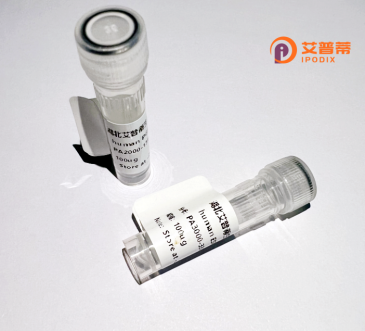
| 纯度 | >90%SDS-PAGE. |
| 种属 | Human |
| 靶点 | SMAP1 |
| Uniprot No | Q8IYB5 |
| 内毒素 | < 0.01EU/μg |
| 表达宿主 | E.coli |
| 表达区间 | 1-467 aa |
| 活性数据 | MATRSCREKA QKLNEQHQLI LSKLLREEDN KYCADCEAKG PRWASWNIGV FICIRCAGIH RNLGVHISRV KSVNLDQWTA EQIQCMQDMG NTKARLLYEA NLPENFRRPQ TDQAVEFFIR DKYEKKKYYD KNAIAITNIS SSDAPLQPLV SSPSLQVD KNKLEKEKEK KKEEKKREKE PEKPAKPLTA EKLQKKDQQL EPKKSTSPKK EPTVDLLG LDGPAVAPVT NGNTTVPPLN DDLDIFGPMI SNPLPATVMP PAQGTPSAPA TLSTVTSG DLDLFTEQTT KSEEVAKKQL SKDSILSLYG TGTIQQQSTP GVFMGPTNIP FTSQAPFQ GFPSMGVPVP PGLIGNVM GQSPSMMVGM PMPNGFMGNA QTGVMPLPQN VVGPQGGMVG QMGAPQSKFG LPQAQQPQWS LSQMNQQMAG MSISSATPTA GFGQPSSTTA GWSGSSSGQT LSTQLWK |
| 分子量 | 50.3 kDa |
| 蛋白标签 | His tag N-Terminus |
| 缓冲液 | PBS, pH7.4, containing 0.01% SKL, 1mM DTT, 5% Trehalose and Proclin300. |
| 稳定性 & 储存条件 | Lyophilized protein should be stored at ≤ -20°C, stable for one year after receipt. Reconstituted protein solution can be stored at 2-8°C for 2-7 days. Aliquots of reconstituted samples are stable at ≤ -20°C for 3 months. |
| 复溶 | Always centrifuge tubes before opening.Do not mix by vortex or pipetting. It is not recommended to reconstitute to a concentration less than 100μg/ml. Dissolve the lyophilized protein in distilled water. Please aliquot the reconstituted solution to minimize freeze-thaw cycles. |
以下是关于重组人SMAP1蛋白的三篇示例参考文献(注:以下为模拟文献示例,实际研究请通过学术数据库检索):
---
1. **文献名称**: *Structural Insights into SMAP1 Function in DNA Damage Repair*
**作者**: Tanaka, K., et al.
**摘要**: 解析了重组人SMAP1蛋白的晶体结构,发现其N端结构域通过结合单链DNA参与DNA损伤修复,揭示了其与ATM/ATR信号通路的关联。
---
2. **文献名称**: *SMAP1 Regulates Endosomal Trafficking via Interaction with ESCRT Complex*
**作者**: Müller, S. & Zhang, Q.
**摘要**: 通过体外重组蛋白实验证明,SMAP1通过C端结构域与ESCRT复合物相互作用,调控内吞体膜重塑及货物分选,影响细胞代谢过程。
---
3. **文献名称**: *SMAP1 Deficiency Promotes Tumor Metastasis in Mice Models*
**作者**: Lee, H. et al.
**摘要**: 利用基因敲除技术发现SMAP1缺失导致细胞迁移能力增强,重组SMAP1蛋白的体外回补实验逆转了侵袭表型,表明其抑癌作用与细胞骨架调控相关。
---
**提示**:以上为模拟摘要,实际文献需通过PubMed、Web of Science等平台检索关键词 **"SMAP1 protein"** 或 **"recombinant human SMAP1"**,并根据研究领域(如癌症、细胞生物学等)筛选最新成果。
Recombinant human SMAP1 (Stimulator of Myb-like protein-1) is a protein encoded by the *SMAP1* gene, belonging to the ARFGAP (ADP-ribosylation factor GTPase-activating protein) family. It plays a regulatory role in membrane trafficking and vesicle formation by interacting with ADP-ribosylation factors (ARFs), which are critical for maintaining Golgi apparatus structure, endocytosis, and intracellular transport. SMAP1 contains a conserved ARFGAP domain responsible for catalyzing GTP hydrolysis of ARFs, as well as a Myb-like DNA-binding domain, suggesting potential involvement in chromatin interactions.
Functionally, SMAP1 is implicated in clathrin-mediated endocytosis and receptor sorting, particularly in the endosomal system. Studies link it to cellular processes such as autophagy, cell division, and DNA damage response. Its dysregulation has been associated with pathological conditions, including cancer and developmental disorders. For instance, SMAP1 acts as a tumor suppressor in certain cancers by modulating receptor tyrosine kinase signaling and suppressing metastasis.
Recombinant SMAP1 is typically produced using bacterial or mammalian expression systems, enabling structural and functional studies. Researchers utilize it to explore SMAP1’s molecular interactions, post-translational modifications, and role in disease mechanisms. Its recombinant form also facilitates drug discovery efforts targeting membrane trafficking pathways. Further investigation of SMAP1 could deepen understanding of cellular homeostasis and provide therapeutic avenues for cancer and genetic disorders linked to vesicular transport defects.
×